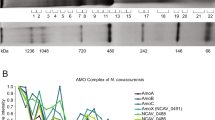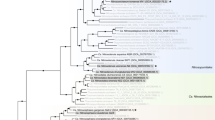Abstract
Nitrification plays an important role in marine biogeochemistry, yet efforts to link this process to the microorganisms that mediate it are surprisingly limited. In particular, ammonia oxidation is the first and rate-limiting step of nitrification, yet ammonia oxidation rates and the abundance of ammonia-oxidizing bacteria (AOB) have rarely been measured in tandem. Ammonia oxidation rates have not been directly quantified in conjunction with ammonia-oxidizing archaea (AOA), although mounting evidence indicates that marine Crenarchaeota are capable of ammonia oxidation, and they are among the most abundant microbial groups in the ocean. Here, we have directly quantified ammonia oxidation rates by 15N labeling, and AOA and AOB abundances by quantitative PCR analysis of ammonia monooxygenase subunit A (amoA) genes, in the Gulf of California. Based on markedly different archaeal amoA sequence types in the upper water column (60 m) and oxygen minimum zone (OMZ; 450 m), novel amoA PCR primers were designed to specifically target and quantify ‘shallow’ (group A) and ‘deep’ (group B) clades. These primers recovered extensive variability with depth. Within the OMZ, AOA were most abundant where nitrification may be coupled to denitrification. In the upper water column, group A tracked variations in nitrogen biogeochemistry with depth and between basins, whereas AOB were present in relatively low numbers or undetectable. Overall, 15NH4+ oxidation rates were remarkably well correlated with AOA group A amoA gene copies (r2=0.90, P<0.001), and with 16S rRNA gene copies from marine Crenarchaeota (r2=0.85, P<0.005). These findings represent compelling evidence for an archaeal role in oceanic nitrification.
Similar content being viewed by others
Log in or create a free account to read this content
Gain free access to this article, as well as selected content from this journal and more on nature.com
or
References
Alvarez-Borrego S, Rivera JA, Gaxiola-Castro G, Acosta-Ruiz M, Schwartzlose RA . (1978). Nutrientes in el Golfo de California. Cienc Mar 5: 53–71.
Beman JM, Arrigo KR, Matson PA . (2005). Agricultural runoff fuels large phytoplankton blooms in vulnerable areas of the ocean. Nature 434: 211–214.
Beman JM, Francis CA . (2006). Diversity of ammonia-oxidizing Archaea and bacteria in the sediments of a hypernutrified subtropical estuary: Bahía del Tóbari, Mexico. Appl Environ Microbiol 72: 7677–7777.
Beman JM, Roberts KJ, Wegley L, Rohwer F, Francis CA . (2007). Distribution and diversity of archaeal ammonia monooxygenase genes associated with corals. Appl Environ Microbiol 73: 5642–5647.
Chao A, Chazdon RL, Colwell RK, Shen T-J . (2005). A new statistical approach for assessing similarity of species composition with incidence and abundance data. Ecol Lett 8: 148–159.
Codispoti LA, Christensen JP . (1985). Nitrification, denitrification and nitrous oxide cycling in the eastern tropical South Pacific ocean. Mar Chem 16: 277–300.
Coolen MJL, Abbas B, van Bleijswijk J, Hopmans EC, Kuypers MMM, Wakeham SG et al. (2007). Putative ammonia-oxidizing Crenarchaeota in suboxic waters of the Black Sea: a basin-wide ecological study using 16S ribosomal and functional genes and membrane lipids. Environ Microbiol 9: 1001–1016.
DeLong EF . (1992). Archaea in coastal marine environments. Proc Natl Acad Sci USA 89: 5685–5689.
DeLong EF, Wu KY, Prézelin BB, Jovine RVM . (1994). High abundance of Archaea in Antarctic marine picoplankton. Nature 371: 695–697.
Dore JE, Karl DM . (1996). Nitrification in the euphotic zone as a source of nitrite, nitrate and nitrous oxide at Station ALOHA. Limnol Oceanogr 41: 1619–1628.
Dore JE, Popp BN, Karl DM, Sansone FJ . (1998). A large source of atmospheric nitrous oxide from subtropical North Pacific surface waters. Nature 396: 63–66.
Francis CA, Beman JM, Kuypers MMM . (2007). New processes and players in the nitrogen cycle: the microbial ecology of anaerobic and archaeal ammonia oxidation. ISME J 1: 19–27.
Francis CA, Roberts KJ, Beman JM, Santoro AE, Oakley BB . (2005). Ubiquity and diversity of ammonia-oxidizing archaea in water columns and sediments of the ocean. Proc Natl Acad Sci USA 102: 14683–14688.
Fuhrman JA, McCallum K, Davis AA . (1992). Novel major archaebacterial group from marine plankton. Nature 356: 148–149.
Garcia-Martinez J, Rodriguez-Valera F . (2000). Microdiversity of uncultured marine prokaryotes: the SAR11 cluster and the marine Archaea of Group I. Mol Ecol 9: 935–948.
Hallam SJ, Konstantinidis KT, Putnam N, Schleper C, Watanabe Y-I, Sugahara J et al. (2006a). Genomic analysis of the uncultivated marine crenarchaeote Cenarchaeum symbiosum. Proc Natl Acad Sci USA 103: 18296–18301.
Hallam SJ, Mincer TJ, Schleper C, Preston CM, Roberts K, Richardson PM et al. (2006b). Pathways of carbon assimilation and ammonia oxidation suggested by environmental genomic analyses of marine Crenarchaeota. PLoS Biol 4: e95.
Hamersley MR, Lavik G, Woebken D, Rattray JE, Lam P, Hopmans EC et al. (2007). Anaerobic ammonium oxidation in the Peruvian oxygen minimum zone. Limnol Oceanogr 52: 923–933.
Hollibaugh JT, Bano N, Ducklow HW . (2002). Widespread distribution in polar oceans of a 16S rRNA gene sequence with affinity to Nitrosospira-like ammonia-oxidizing bacteria. Appl Environ Microbiol 68: 1478–1484.
Holmes RM, Aminot A, Kérouel R, Hooker BA, Peterson BJ . (1999). A simple and precise method for measuring ammonium in marine and freshwater ecosystems. Can J Fish Aquat Sci 56: 1801–1808.
Ingalls AE, Shah SR, Hansman RL, Aluwihare LI, Santos GM, Druffel ERM et al. (2006). Quantifying archaeal community autotrophy in the mesopelagic ocean using natural radiocarbon. Proc Natl Acad Sci USA 103: 6442–6447.
Karl DM, Knauer GA, Martin JH, Ward BB . (1984). Bacterial chemolithotrophy in the ocean is associated with sinking particles. Nature 309: 54–56.
Karner MB, DeLong EF, Karl DM . (2001). Archaeal dominance in the mesopelagic zone of the Pacific Ocean. Nature 409: 507–510.
Kirchman DL, Elifantz H, Dittel AI, Malmstrom RR, Cottrell MT . (2007). Standing stocks and activity of Archaea and Bacteria in the western Arctic Ocean. Limnol Oceanogr 52: 495–507.
Könneke M, Bernhard AE, de la Torre JR, Walker CB, Waterbury JB, Stahl DA . (2005). Isolation of an autotrophic ammonia-oxidizing marine archaeon. Nature 437: 543–546.
Kuypers MMM, Blokker P, Erbacher J, Kinkel H, Pancost RD, Schouten S et al. (2001). Massive expansion of marine Archaea during a mid-Cretaceous anoxic event. Science 293: 92–94.
Kuypers MMM, Lavik G, Woebken D, Schmid M, Fuchs BM, Amann R et al. (2005). Massive nitrogen loss from the Benguela upwelling system through anaerobic ammonium oxidation. Proc Natl Acad Sci USA 102: 6478–6483.
Lam P, Jensen MM, Lavik G, McGinnis DF, Muller B, Schubert CJ et al. (2007). Linking crenarchaeal and bacterial nitrification to anammox in the Black Sea. Proc Natl Acad Sci USA 104: 7104–7109.
Leininger S, Urich T, Schloter M, Schwark L, Qi J, Nicol GW et al. (2006). Archaea predominate among ammonia-oxidizing prokaryotes in soils. Nature 442: 806.
Ludwig W, Strunk O, Westram R, Richter L, Meier H, Kumar Y et al. (2004). ARB: a software environment for sequence data. Nucleic Acids Res 32: 1363–1371.
Massana R, DeLong EF, Pedros-Alio C . (2000). A few cosmopolitan phylotypes dominate planktonic archaeal assemblages in widely different oceanic provinces. Appl Environ Microbiol 66: 1777–1787.
Mincer TJ, Church MJ, Taylor LT, Preston CM, Karl DM, DeLong EF . (2007). Quantitative distribution of presumptive archaeal and bacterial nitrifiers in Monterey Bay and the North Pacific Subtropical Gyre. Environ Microbiol 9: 1162–1175.
Murray AE, Blakis A, Massana R, Strawzewski S, Passow U, Alldredge A et al. (1999). A time series assessment of plaktonic archaeal variability in the Santa Barbara Channel. Aquat Microb Ecol 20: 129–145.
Norton J, Alzerreca J, Suwa Y, Klotz M . (2002). Diversity of ammonia monooxygenase operon in autotrophic ammonia-oxidizing bacteria. Arch Microbiol 177: 139–149.
Park H-D, Wells GF, Bae H, Criddle CS, Francis CA . (2006). Occurrence of Ammonia-Oxidizing Archaea in Wastewater Treatment Plant Bioreactors. Appl Environ Microbiol 72: 5643–5647.
Pearson A, McNichol AP, Benitez-Nelson BC, Hayes JM, Eglinton TI . (2001). Origns of lipid biomarkers in Santa Monica Basin surface sediment: a case study using compound-specific 14C analysis. Geochim Cosmochim Acta 65: 3123–3137.
Popp BN, Westley MB, Toyoda S, Miwa T, Dore JE, Yoshida N et al. (2002). Nitrogen and oxygen isotopomeric constraints on the origins and sea-to-air flux of N2O in the oligotrophic subtropical North Pacific gyre. Global Biogeochem Cycles 16: 1064 (doi:10.1029/2001GB001806).
Prahl FG, Popp BN, Karl DM, Sparrow MA . (2005). Ecology and biogeochemistry of alkenone production at subtropical North Pacific Station ALOHA. Deep-Sea Research I 52: 699–719.
Purkhold U, Pommerening-Roser A, Juretschko S, Schmid MC, Koops H-P, Wagner M . (2000). Phylogeny of all recognized species of ammonia oxidizers based on comparative 16S rRNA and amoA sequence analysis: implications for molecular diversity surveys. Appl Environ Microbiol 66: 5368–5382.
Roberts CM, McClean CJ, Veron JEN, Hawkins JP, Allen GR, McAllister DE et al. (2002). Marine biodiversity hotspots and conservation priorities for tropical reefs. Science 295: 1280–1284.
Roden GI . (1958). Oceanographic and meteorological aspects of the Gulf of California. J Mar Res 18: 10–35.
Rotthauwe JH, Witzel KP, Liesack W . (1997). The ammonia monooxygenase structural gene amoA as a functional marker: molecular fine-scale analysis of natural ammonia-oxidizing populations. Appl Environ Microbiol 63: 4704–4712.
Sansone FJ, Popp BN, Rust TM . (1997). Stable carbon isotopic analysis of low-level methane in water and gas. Anal Chem 69: 40–44.
Santoro AE, Boehm AB . (2007). Frequent occurrence of the human-specific Bacteroides fecal marker at an open coast marine beach: relationship to waves, tides and traditional indicators. Environ Microbiol 9: 2038–2049.
Santoro AE, Francis CA, de Sieyes NR, Boehm AB . (in press). Shifts in the relative abundance of ammonia-oxidizing bacteria and archaea across physicochemical gradients in a subterranean estuary. Environ Microbiol (doi:10.1111/j.1462-2920.2007.01547x).
Schleper C, Jurgens G, Jonuscheit M . (2005). Genomic studies of uncultivated archaea. Nat Rev Microbiol 3: 479–488.
Schloss PD, Handelsman J . (2006). Introducing SONS, a tool for operational taxonomic unit-based comparisons of microbial community memberships and structures. Appl Environ Microbiol 72: 673–679.
Sigman DM, Casciotti KL, Andreani M, Barford C, Galanter M, Böhlke JK . (2001). A bacterial method for the nitrogen isotopic analysis of nitrate in seawater and freshwater. Anal Chem 73: 4145–4153.
Sinninghe Damste JS, Rijpstra WIC, Hopmans EC, Prahl FG, Wakeham SG, Schouten S . (2002). Distribution of membrane lipids of planktonic crenarchaeota in the Arabian Sea. Appl Environ Microbiol 68: 2997.
Strickland JH, Parsons TR . (1972). A Practical Handbook of Seawater Analysis, 2nd edn. Fish. Res. Board: Ottawa, Ontario, Canada.
Sutka RL, Ostrom NE, Ostrom PH, Phanikumar MS . (2004). Stable nitrogen isotope dynamics of dissolved nitrate in a transect from the north Pacific subtropical gyre to the eastern tropical north Pacific. Geochim Cosmochim Acta 68: 517–527.
Venter JC, Remington K, Heidelberg JF, Halpern AL, Rusch D, Eisen JA et al. (2004). Environmental genome shotgun sequencing of the Sargasso Sea. Science 304: 66–74.
Ward BB . (1987). Nitrogen transformations in the Southern California Bight. Deep Sea Res A 34: 785–805.
Ward BB . (2000). Nitrification and the marine nitrogen cycle. In: Kirchman D (ed). Microbial Ecology of the Oceans. Wiley and Sons: New York. pp 427–454.
Ward BB . (2005). Temporal variability in nitrification rates and related biogeochemical factors in Monterey Bay, California, USA. Marine Ecol Prog Ser 292: 97–109.
Ward BB, Glover HE, Lipschultz F . (1989). Chemoautotrophic activity and nitrification in the oxygen minimum zone off Peru. Deep Sea Res A 36: 1031–1051.
Ward BB, O'Mullan GD . (2002). Worldwide Distribution of Nitrosococcus oceani, a marine ammonia-oxidizing gamma-proteobacterium, detected by PCR and sequencing of 16S rRNA and amoA genes. Appl Environ Microbiol 68: 4153–4157.
Ward BB, O'Mullan GD . (2005). Community level analysis: genetic and biogeochemical approaches to investigate community composition and function in aerobic ammonia oxidation. Methods Enzymol, 395–413.
Ward BB, Zafiriou OC . (1988). Nitrification and nitric oxide in the oxygen minimum of the eastern tropical North Pacific. Deep Sea Res A 35: 1127–1142.
Watson SW . (1965). Characteristics of a marine nitrifying bacterium, Nitrosocystis oceanus sp.n. Limnol Oceanogr 10: R274–R289.
White AE, Prahl FG, Letelier RM, Popp BN . (2007). Summer surface waters in the Gulf of California: prime habitat for biological N2 fixation. Global Biogeochem Cycles 21: GB2017 (doi:10.1029/2006GB002779).
Wuchter C, Abbas B, Coolen MJL, Herfort L, van Bleijswijk J, Timmers P et al. (2006). Archaeal nitrification in the ocean. Proc Natl Acad Sci USA 103: 12317–12322.
Wuchter C, Schouten S, Boschker HTS, Sinnighe Damsté JS . (2003). Bicarbonate uptake by marine Crenarchaeota. FEMS Microbiol Lett 219: 203–207.
Yamagishi H, Westley MB, Popp BN, Toyoda S, Yoshida N, Watanabe S et al. (2007). Role of nitrification and denitrification on the nitrous oxide cycle in the eastern tropical North Pacific and Gulf of California. J Geophys Res 112: G02015 (doi:10.1029/2006JG000227).
Yool A, Martin AP, Fernandez C, Clark DR . (2007). The significance of nitrification for oceanic new production. Nature 447: 999–1002.
Zeitzschel B . (1969). Primary productivity in the Gulf of California. Mar Biol 3: 201–207.
Acknowledgements
We thank F Prahl, G Dick, C DuPont, T Rust, C Sheehan, N Wallsgrove, R Wallsgrove and A White for their help with sampling, various aspects of sample collection and analysis, cruise preparation and data processing. We also thank H-D Park, A Santoro and J Fuhrman for advice and assistance, D Karl for comments on an earlier version of this paper and acknowledge the officers and crew of the R/V New Horizon for all of their efforts. JMB and CAF were supported in part by NSF Grant MCB-0604270, and this work was supported in part by NSF Grant OCE-03234299 (to BNP). This is SOEST contribution number 7238.
Author information
Authors and Affiliations
Corresponding author
Rights and permissions
About this article
Cite this article
Beman, J., Popp, B. & Francis, C. Molecular and biogeochemical evidence for ammonia oxidation by marine Crenarchaeota in the Gulf of California. ISME J 2, 429–441 (2008). https://doi.org/10.1038/ismej.2007.118
Received:
Revised:
Accepted:
Published:
Issue date:
DOI: https://doi.org/10.1038/ismej.2007.118
Keywords
This article is cited by
-
Particle-associated denitrification is the primary source of N2O in oxic coastal waters
Nature Communications (2023)
-
Global patterns of diversity and metabolism of microbial communities in deep-sea hydrothermal vent deposits
Microbiome (2022)
-
Effects of Soil Salinity on Nitrification and Ammonia-Oxidizing Microorganisms in Coastal Reclaimed Farmland Soil
Journal of Soil Science and Plant Nutrition (2022)
-
Comparison of 16S rRNA Gene Primers on Studying Microbial Community Composition in Bottom Water and Sediment of Artificial Reefs in Laoshan Bay, China
Journal of Ocean University of China (2022)
-
Genome-resolved metagenomics analysis provides insights into the ecological role of Thaumarchaeota in the Amazon River and its plume
BMC Microbiology (2020)



